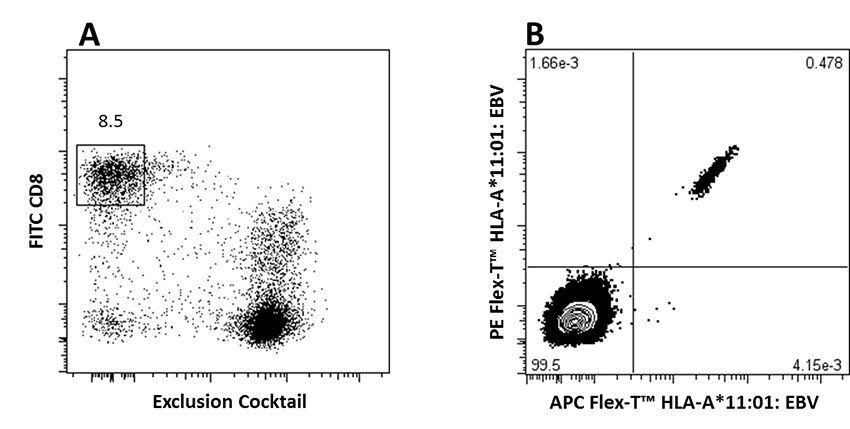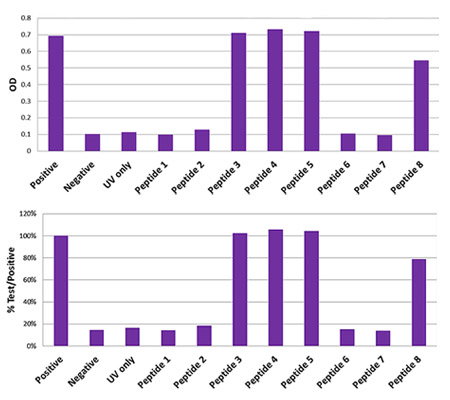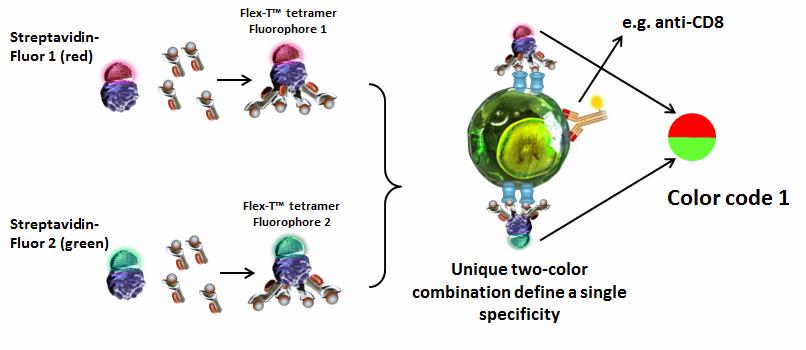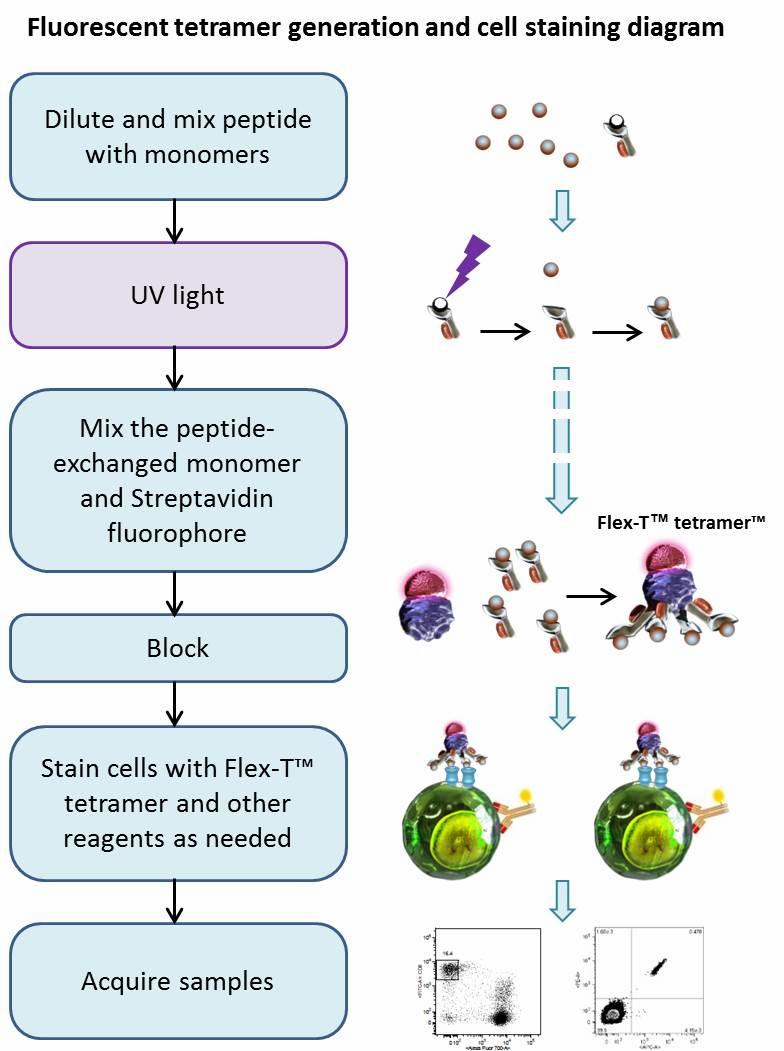Uncover antigen-specific T cells with Flex-T™ Major Histocompatibility Complex (MHC) tetramers. For increased flexibility, our MHC monomers are available with either UV-labile peptides that can be replaced with any peptide of interest, or pre-loaded with disease-relevant peptides. Once assembled into tetramers, they can be used in flow cytometry to detect T cells based on their unique receptor.
Flex-T™
Introduction
What are MHC tetramers and what can you do with them?
The T-cell mediated immune response is defined by the interaction between antigen presenting cells and T cells, through the Major Histocompatibility Complex (MHC) and the T cell receptor (TCR). MHC molecules present a peptide to antigen-specific T cells that recognize this peptide. Soluble, monomeric MHC molecules bind very weakly to the TCR. However, by making a tetramer through a fluorescently labeled streptavidin conjugate, the complex has greater avidity to the T cell and maintains more stable binding by interacting with several TCRs, making it useful for flow cytometry detection of antigen specific T cells.
What is a Flex-T™?
Flex-T™ is BioLegend's technology to study antigen-specific T cells through their TCRs. It has the unique property of allowing the loading of peptides of interest into the binding site of the MHC groove, by using ultraviolet (UV) light labile, exchangeable peptides. Flex-T™ technology features:
- Flexible peptide loading
- Two color combination capability
- High throughput screening
- High specificity
- Ease of use
- Affordability
How does ultraviolet peptide exchange work?
Flex-T™ is made of MHC monomers loaded with a peptide that can be degraded by the use of a UV light source. This allows for a peptide exchange when the UV irradiation is done in the presence of the peptide of interest (which is not UV-labile). This flexibility permits the screening of virtually any peptide of interest with enough affinity for the MHC allele that it is loaded onto.

Representative Data
To increase the resolution when detecting antigen-specific T cells with MHC tetramers, at the same time that improves the specificity of the assay, we recommend a two color staining with the same allele/peptide combination. Furthermore, each allele can be coded with a unique two-color combination, allowing for the detection of multiple antigen-specific T cells at the same time.

A) CD8+ T Cells previously gated on lymphocytes (FSC vs SSC) and 7-AAD negative events, the exclusion cocktail contains Alexa Fluor® 700 anti- CD4, CD19, CD14, and CD16. B) Antigen-specific CD8+ T Cells, gated as described, detected with Flex-T™ tagged with PE and APC. HLA-A*11:01 Flex-T™ is loaded with EBV peptide (IVTDFSVIK).
Use our Human Class I Peptide Exchange ELISA kit to qualitatively evaluate the efficiency of the UV peptide exchange when building MHC Tetramers with Flex-T™ reagents prior to cell staining. Each kit comes with validated, ready-to-use reagents including a pre-coated plate and positive control.

Flex-T™ HLA-A*02:01 UVX monomer was treated with a 366nm UV in the presence of a Positive or Negative control peptide, a test peptide, or no peptide (UV-only). After peptide exchange, each reaction mixture was then diluted and analyzed by the ELISA. The optical densities of each sample calculated by absorbance at 450 nm subtracted with absorbance at 570 nm are shown in upper bar graph and the percentile (%) of test peptide against Positive control peptide in lower bar graph.
Sequence of positive and negative peptide controls:
| Allele | Positive | Negative |
|---|---|---|
| HLA-A*01:01 | CTELKLSDY | NPKASLLSL |
| HLA-A*02:01 | NLVPMVATV | IVTDFSVIK |
| HLA-A*02:03 | NLVPMVATV | NPKASLLSL |
| HLA-A*03:01 | LIYRRRLMK | NPKASLLSL |
| HLA-A*11:01 | IVTDFSVIK | NPKASLLSL |
| HLA-A*24:02 | YYLEKANKI | NLVPMVATV |
| HLA-B*07:02 | NPKASLLSL | LIYRRRLMK |
| HLA-B*08:01 | ELRSRYWAI | NLVPMVATV |
| HLA-B*27:05 | KRWIILGLNK | IVTDFSVIK |
| HLA-C*04:01 | YFDPANGKF | CTELKLSDY |
Combinatorial color coding*
When using MHC multimers to study antigen-specific T cells, each MHC/peptide detects only a small fraction of T cells that are specific for that peptide. Thus, for a large screening of several specificities a proportionally large volume of blood or sample will be needed. To address this issue, an excellent strategy is to use a "combinatorial color coding"1. The method consist in assigning a unique two-color code to each tetramer/peptide of interest. Two tetramers tagged with different colors will bind to the TCRs, yielding a specific T cell that can be detected in two channels in a flow cytometer. By analyzing the double positive cells it is possible to identify the peptide that those cells are recognizing.
The number of tetramer/peptide combinations that can be used simultaneously depend on how many fluorophores are used to assemble the tetramers. Using 5 different streptavidin-fluorophore conjugates allows for 10 unique two-color combinations (light blue region, table 1). Using 6 conjugates, the codes expand to 15 (light red region, table 1). The codes increase as the number of conjugates increase. Thus, as you increase the colors used, more specificities can be covered and less sample is required. The use of BioLegend's Flex-T™ technology allows for an efficient and affordable solution for antigen-specific T cell multi screening. The cost of the reagents is much lower than other commercially available products. In addition, we offer in-house, custom screening. Please contact our Custom Solution Team for a quote: cst@biolegend.com.
Table 1. Possible combinations of two-color codes depend on the number of Streptavidin-fluorophore conjugates used to generate the tetramer/peptide complex

1) Hadrup SR et al. Parallel detection of antigen-specific T-cell responses by multidimensional encoding of MHC multimers. Nat Methods. 2009 Jul;6(7):520-6.
The Flex-T™ products and its uses are patent protected in multiple countries, in particular by patent families identified by PCT publications WO 2006/080837 and WO 2010/060439. WO 2006/080837 claims cover among others the UV-conditional peptide-MHC exchange. WO 2010/060439 claims cover among others the combinatorial coding MHC detection system.
Products
Our Flex-T™ reagents include biotinylated monomers containing UV-labile peptides or pre-loaded with fixed peptides, ELISA reagents to evaluate the efficiency of peptide exchange, and custom monomers and tetramers. Click each product family below to view the full list of available products.
Mouse Class I Biotinylated Monomers- Fixed Peptides
Human Class I Biotinylated Monomers- UV-labile Peptides
Human Class I Biotinylated Monomers- Fixed Peptides
To order custom products please fill out the Custom Flex-T™ Request Form
Reagents are for research use only. Any use of the reagents for commercial applications require an additional license agreement. Please contact BioLegend Business Development for more information.
| Human Class I Biotinylated Monomer-SARS-CoV-2 Fixed Peptides (25 µg) |
|---|
| Flex-T™ Biotin HLA-A SARS-CoV-2 Membrane Protein Monomer |
| Flex-T™ Biotin HLA-A SARS-CoV-2 Nucleocapsid Monomer |
| Flex-T™ Biotin HLA-A SARS-CoV-2 ORF1ab Monomer |
| Flex-T™ Biotin HLA-A SARS-CoV-2 ORF3a Monomer |
| Flex-T™ Biotin HLA-A SARS-CoV-2 Spike Protein Monomer |
| Mouse Class I Biotinylated Monomer- Fixed Peptide (25 µg) |
|---|
| Flex-T™ Biotin H-2 D(b) Monomers |
| Flex-T™ Biotin H-2 K(b) Monomers |
| Flex-T™ Biotin H-2 K(d) Monomers |
| Human Class I Biotinylated Monomer- UV-labile Peptide | Size |
|---|---|
| Flex-T™ HLA-A*01:01 Monomer UVX | 50 µg |
| Flex-T™ HLA-A*02:01 Monomer UVX | 50 µg | 200 µg |
| Flex-T™ HLA-A*02:03 Monomer UVX | 50 µg |
| Flex-T™ HLA-A*03:01 Monomer UVX | 50 µg |
| Flex-T™ HLA-A*11:01 Monomer UVX | 50 µg |
| Flex-T™ HLA-A*24:02 Monomer UVX | 50 µg |
| Flex-T™ HLA-B*07:02 Monomer UVX | 50 µg |
| Flex-T™ HLA-B*08:01 Monomer UVX | 50 µg |
| Flex-T™ HLA-B*15:01 Monomer UVX | 50 µg |
| Flex-T™ HLA-C*04:01 Monomer UVX | 50 µg |
| Flex-T™ HLA-C*07:01 Monomer UVX | 50 µg |
| Flex-T™ HLA-C*07:02 Monomer UVX | 50 µg |
| ELISA Reagents | Size |
|---|---|
| LEGEND MAX™ Flex-T™ Human Class I Peptide Exchange ELISA Kit | 1 pre-coated plate |
| Purified Streptavidin | 250 µg |
| HRP anti-human β2-microglobulin antibody | 50 µg |
| Flex-T™ ELISA Positive Control | 20 µg |
| Custom Flex-T™ Reagents | Size |
|---|---|
|
50 µg | 200 µg |
|
|
50 tests | 200 tests |
|
|
50 µg | 200 µg |
|
|
50 tests | 200 tests |
Useful links
A collaboration between the Departments of Bio and Health Informatics, the Department of Immunology and Microbiology, from the Copenhagen Business School and the University of Copenhagen, and La Jolla Institute for Allergy and Immunology, has resulted in a software to predict peptide-MHC class I binding using artificial neural networks (ANNs). You can test a peptide sequence here: http://www.cbs.dtu.dk/services/NetMHCpan-4.0/
Reference: https://www.ncbi.nlm.nih.gov/pubmed/28978689
The Immune Epitope Database (IEDB) is a free resource from the NIAID that predicts and analyzes epitopes. The database collects experimental data, including published datasets, regarding T cell and antibody epitopes relevant to infectious disease, allergy, autoimmunity, and transplantations. Use the tools at: https://www.iedb.org/home_v3.php
MHC Antigen Peptides: https://www.biolegend.com/nl-nl/antigen-peptides
What are MHC tetramers and what can you do with them?
The T-cell mediated innate immune response is defined by the interaction between antigen presenting cells and T cells, through the Major Histocompatibility Complex (MHC) and the T cell receptor (TCR). MHC molecules present a peptide to antigen-specific T cells that recognize this peptide. Soluble, monomeric MHC molecules bind very weakly to the TCR. However, by making a tetramer through a fluorescently labeled streptavidin conjugate, the complex binds to several TCRs, creating a more stable interaction and making it useful for flow cytometric detection of antigen specific T cells.
What is Flex-T™?
Flex-T™ (Flexible-Tetramers) is BioLegend’s brand name for our Soluble MHC product line. It encompasses monomers, the ultraviolet (UV) peptide exchange technology, and all associated products and applications.
Is there any advantage in buying biotinylated monomers?
Yes, the same monomer can be assembled with different Streptavidin conjugates, providing great flexibility for color choices.
Additionally, it can be stored frozen and the tetramer assembled shortly before the experiment. This increases the storage time of the reagent.
What is the peptide exchange technology and what’s the advantage of using it?
Flex-T™ MHC monomers are loaded with a peptide that can be degraded by the use of a UV light source. This allows for a peptide exchange when the UV irradiation is done in the presence of the peptide of interest (which is not UV-labile). This flexibility permits the screening of virtually any peptide of interest with enough affinity for the MHC allele that it is loaded onto.
What are the specifications of the UV source?
UV Lamp, long-wave UV source (365nm, 8 Watts, or similar). The light source should allow sample to be placed 2 – 5 cm away from the lamp.
How do I evaluate the efficiency of the peptide exchange?
Follow the protocol for HLA class I ELISA. An assay positive control can be purchased separately (Cat#280301), and it can be diluted to a high, medium, and low concentration. Signal intensity can be correlated to affinity of the peptide.
Is there any peptide length recommended?
There are no special requirements for the peptides. Peptides that naturally bind to MHC molecules will bind to Flex-T™ reagents. For class I molecules, typical length is about 8 – 10 amino acids. Class II molecules accommodate longer peptides, about 14 – 20 amino acids1.
1) Mohan JF and Unanue ER. Unconventional recognition of peptides by T cells and the implications for autoimmunity. Nat Rev Immunol. 2012 Oct;12(10):721-8.
Do I need to know the sequence of the UV-labile peptide?
The sequence of the UV-labile peptide is not needed to use the reagent. MHC molecules are not stable without a peptide, so these peptides are used just for two purposes: stabilize the MHC molecules and serve as a place holder to be substituted by the peptide of interest.
If I am still interested in “fixed” peptides, what do you recommend?
Please see the linked document titled “Peptide Sequences”. The document contains a table with commonly used peptides by allele to study antigen specific T cells.
I am interested in finding novel peptides instead, are there any resources for this?
There are a number of databases and webpages that can help, here is one of them: https://www.iedb.org/.
Is it feasible screening not just peptides, but also several specificities of antigen specific T cells in one sample?
With the traditional pre-assembled Tetramer approach, this is difficult to do, and not cost-effective. With Flex-T™ technology, as there is more flexibility to assemble the tetramers, it is easy and affordable to screen a sample for several specificities2. To facilitate this approach, a combinatorial color coding system has been developed. Please visit Flex-T™ webpage at biolegend.com/flex-t, Combinatorial Color Coding tab for a detailed description about how to do this.
2) Hadrup SR et al. Parallel detection of antigen-specific T-cell responses by multidimensional encoding of MHC multimers. Nat Methods. 2009 Jul;6(7):520-6.
Do you offer mouse monomers or tetramers?
Not currently.
Do you offer custom products and services?
Yes, please contact our Custom Solution Team with your request at cst@biolegend.com, or contact your local BioLegend representative.
Are Flex-T™ products patent protected?
The Flex-T™ products and its uses are patent protected in multiple countries, in particular by patent families identified by PCT publications WO 2006/080837 and WO 2010/060439. WO 2006/080837 covers among others the UV-conditional peptide-MHC exchange. WO 2010/060439 covers among others the combinatorial coding MHC detection system.
The Flex-T™ products are sold with a limited use license for non-commercial research (Flex-T™️ Specific Limited Use License) For other uses, a license can be obtained from Sanquin. Please contact reagents@sanquin.nl for more information.
 Login / Register
Login / Register 








Follow Us